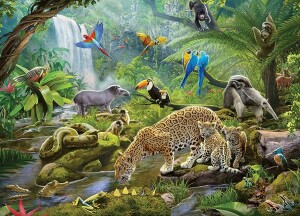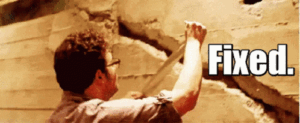
As I am near the completion of my Animal Habitat module for Grade 2 students, I’m reflecting on the entire course design journey, particularly how my first project—the interactive recycling course—has influenced the development of this new module. The experience of creating my first course helped me develop new skills, learn from feedback, and refine my approach to designing engaging, accessible, and educational content. This Animal Habitat module builds on those lessons learned, taking into account everything I discovered while creating the Recycling module and applying it to a fresh, exciting new topic.
Overview of the Course Prototype

The Animal Habitat module is designed to teach Grade 2 students about the different environments where animals live. It incorporates interactive videos, quizzes, discussions, creative assignments, and hands-on activities to foster engagement and deep understanding.
This module is divided into several key parts: 
-
Introduction to Animal Habitats: Students explore various habitats such as forests, oceans, and deserts, learning how different animals are suited to these environments.
-
Animal Adaptations: Students investigate how animals are uniquely adapted to their habitats.
-
Interactive Learning: Through activities such as drag-and-drop worksheets and quizzes, students actively reinforce their learning.
-
Creative Expression: Students will draw their favorite animal in its habitat, helping them visualize and understand the concepts in a fun and creative way.
The course aims to be both engaging and educational, encouraging students to interact with the content, share their thoughts, and apply what they’ve learned in meaningful ways.
Course Profile
For more detailed information on the structure and goals of the course, you can refer to my previous blog post, where I outlined my course profile. In that post, I discussed the learning objectives, student demographics, and my teaching strategies for creating an engaging online learning experience. This current module, designed with the same principles in mind, emphasises interactivity and multimedia to keep young learners engaged.
You can access the course profile here: Course Profile – Animal Habitats
Other links:

Building on the Recycling Module: Lessons Learned and Improvements Made

Reflecting on my first course, the Recycling module, has played a pivotal role in shaping this new project. In that initial attempt, I faced challenges related to simplifying instructions, ensuring accessibility, and creating content that would engage young students. Through feedback and self-reflection, I realized the importance of incorporating more visual cues, diverse activities, and clearer instructions along with recorded instruction to make it easy for those who have difficulty in reading such as Dyslexia. These lessons have greatly influenced the development of the Animal Habitat module.
Key Takeaways from My First Course:

-
Simplified Instructions: In the Recycling module, feedback indicated that some instructions were too complex for young learners. In response, for the Animal Habitat module, I ensured that all instructions were clear, concise, and age-appropriate, using simple language and visual aids to guide the students. I have also added my own recorded video of instruction keeping in mind students feel more connected when they see their teacher.
-
Visual Appeal: One of the key suggestions from the Recycling module was to improve the visuals to make the course more engaging. I took this feedback to heart and designed the Animal Habitat module with more vibrant images, GIF images, interactive elements, and videos, which are visually appealing and capture young students’ attention.
-
Engagement through Activities: In my first course, while activities like quizzes were well-received, there was a desire for more hands-on experiences. To address this, I included a drawing activity where students can create their favorite animal and habitat, fostering creativity and allowing students to apply their learning in a personalized way.
-
Feedback on Accessibility: The feedback from my first course also underscored the need for better accessibility. As a result, I made sure the Animal Habitat module is fully optimized for students with varying technological access, ensuring that it works well on mobile devices and doesn’t require high-speed internet. Also, I have uploaded PDFs for quiz and worksheet, so that in case of internet issues in attempting these assignment online, they can download and do it at home and upload the same.
Overview of the Creation Process

Creating the Animal Habitat module involved a series of steps, some of which were influenced by what I learned from the Recycling module:
-
Interactive Video Creation: Using Lumi, I created an interactive video that introduces students to animal habitats. In this video, students are asked questions like, “Where does this animal live?” and “What kind of environment does this animal need?” I have provided clear instructions this time in the form of text as well my own recorded audio with the same instructions, this is what I learnt from my first project, as they foster easy understanding.
-
Activity Development: I developed a drag-and-drop worksheet that allows students to match animals with their habitats. This is similar to the drag-and-drop activities in the Recycling module, but this time I have provided PDF file for the same for the kids that face internet issues.
-
Creative Assignment: The drawing assignment was designed as a way for students to express their understanding of animal habitats. In the Recycling module, students engaged in a DIY activity, so I decided to carry over that concept of creativity and applied it to drawing. This assignment helps students visualize the connections between animals and their environments, allowing them to take ownership of their learning.
-
Discussion and Reflection: Just like in the Recycling module, I included a discussion prompt, encouraging students to share their favorite animal and discuss where it lives. This allows for peer interaction and deeper reflection on the content. It’s something that worked well in my first course, so I made sure to integrate it into this new module. Another amendment I made is to keep the discussion offline- in class. I consider that this will help me as a teacher to know if students have retained the information from what they learnt in the online content provided in the module.
-
Quizzes and Assessment: As in the Recycling module, I included multiple-choice, true/false, and fill-in-the-blank questions to assess students’ understanding. This consistent format allows students to become familiar with the structure and also provides them with a reliable way to test their knowledge. In this section also I have provided the PDFs for easy access in case of low band-width internet.
Walk through of the Course

To give you a better understanding of the structure and flow of the Animal Habitat module, I’ve created a 10-15 minute walk through screencast. This video takes you through each section of the course, from the interactive video to the quizzes and creative assignments. It’s a great way to see how the activities are integrated and how they all come together to create a comprehensive learning experience for Grade 2 students.
You can watch the walk through here: Animal Habitats Module Walk through
Final Thoughts: From Recycling to Animal Habitats

Looking back, the Recycling module was a crucial learning experience for me as a course designer. While it had its challenges, it gave me the opportunity to refine my skills in interactivity, accessibility, and engagement—all of which directly influenced the design of the Animal Habitat module. By listening to feedback and making adjustments, I’ve been able to create a more polished and effective learning experience that I believe will resonate with young learners.

Moving forward, I’m excited to continue applying the lessons I’ve learned from both modules, especially in ensuring accessibility and equity in my course designs. Whether I’m working on future environmental studies projects or other subjects, I’m confident that these principles will help me create educational content that truly benefits all students.
Thank you for following my journey, and I look forward to receiving more feedback as I continue to refine my course designs!

Neeraj, this is incredible! I appreciate how reflective this blog post is and it speaks to the time, attention, and care you put in to developing your modules for your students. I think the topics you chose to work with (they’re both so interesting and engaging for young learners–everyone, really!) in developing the content and interactive learning opportunities for your students was such a good start in being able to shape experiences for them with what you did in Lumi.
I appreciate how each of your modules speaks to the emphasis you put on accessibility through things like your audio-recording of instructions, having PDF copies of the interactive activities, etc.
Your students are lucky to have you as their teacher!
Hello Neeraj,
Thank you for sharing your journey. I liked reading about how you improved your Animal Habitat module using lessons from your first Recycling module. It is great to see how you made the instructions simpler and added your voice to help pupils understand better.
I also liked how you added hands-on activities like drawing and made the course easy to access, even for students with Internet problems. The idea of having offline discussions in class is smart—it helps teachers know what students are learning.
You are doing a wonderful job creating fun and helpful lessons for young pupils. Keep up the good work!
Hey Neeraj,
Your reflection on the Animal Habitat module is inspiring! It’s great to see how you’ve used the feedback from the Recycling module to enhance clarity, accessibility, and engagement. The use of interactive elements, like drag-and-drop activities and creative assignments, will surely captivate young learners. I especially love the way you’ve incorporated offline access for students with low internet bandwidth. This course seems like a wonderful and thoughtful learning experience for Grade 2 students!
The picture you used at the beginning of the post is really awesome. The picture really aligned with the topic (Animal Habitat Module). Your reflection on the key takeaways was really beautiful. I totally agree with you on the issue of accessibility and visual appeal, particularly when considering the age group of learners you are teaching. I also loved the inclusion of hands-on experiences, where learners had to draw their favourite animal and habitat. This also helps in developing important 21st-century skills outside technology use. Great Job Neeraj.
It’s been awesome to see you progress this semester on your prototype. It has definitely inspired me to try out Canvas in the future. Your drag and drop activities and all the little gamification really add to this. Planning for online learning for such a young age is tough.
Great Job!
Neeraj, I really enjoyed reading about how you built on your first course and brought even more intentionality into your second module. It’s clear that you took feedback seriously and used it to enhance not just the design, but also the student experience. I loved your focus on clarity, interactivity, and accessibility—it’s amazing how much more impactful a course becomes when we center the learner at every step.
One question I’m curious about: What’s one strategy or tool from this module that you’d now consider a “must-have” for any future course you design?
Great work—you’ve shown so much growth throughout this process!
Hi Neeraj, your reflection is a fantastic example of thoughtful growth and intentional design! It’s endearing to see how you took feedback from your first module and applied it so meaningfully to your Animal Habitat module. Your focus on accessibility, interactivity, and student engagementare inspiring, especially the inclusion of offline options and creative assignments. I’m sure your Grade 2 learners will not only enjoy this course but also learn a great deal from it—Congratulations and best wishes!!
You have done a great job – I am in awe on how you managed to make a plan for such young students (a challenge I was not even willing to risk haha!). The course looks great – so many interactive pieces. I have enjoyed reading your reflection on the process and the creation. Great job!